Lessico
Plinio Secondo Gaio
detto il Vecchio
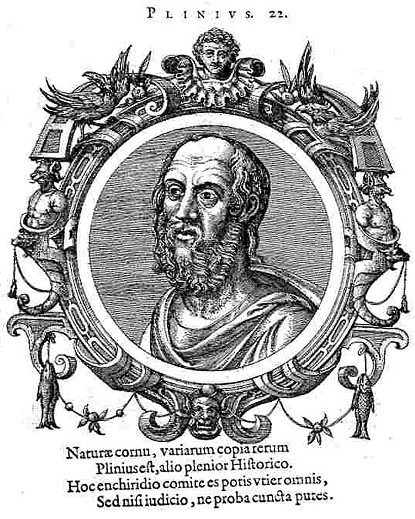
Icones veterum aliquot ac recentium Medicorum
Philosophorumque
Ioannes Sambucus / János Zsámboky![]()
Antverpiae 1574
Erudito
latino (Como 23/24 - Stabia 79). Di famiglia equestre, educato a Roma,
intraprese la carriera militare; fu ufficiale di cavalleria in Germania ai
tempi di Claudio![]() ;
sotto Vespasiano, di cui fu amico, ebbe l'incarico di procuratore imperiale in
varie province.
;
sotto Vespasiano, di cui fu amico, ebbe l'incarico di procuratore imperiale in
varie province.
Nel 79 era comandante della flotta militare a Miseno, quando avvenne la famosa eruzione del Vesuvio che seppellì Pompei, Stabia ed Ercolano: per curiosità scientifica e per soccorrere la popolazione prese il largo con la sua flotta e trovò così la morte.
La sua tragica fine è descritta dal nipote Plinio il Giovane in una famosa lettera a Tacito. Da lui si apprendono anche altri particolari della sua biografia e della sua personalità di integro ufficiale e di appassionato, infaticabile studioso e ricercatore, oltre all'elenco delle opere: due ampie storie, una in 2 libri dedicata alle guerre dei Romani in Germania, l'altra in 31 libri sull'Impero, un manuale sulla formazione dell'oratore (per noi perdute) e la superstite, amplissima Naturalis historia, in 37 libri. I primi dieci libri furono pubblicati nel 77; i successivi uscirono postumi, probabilmente a cura di Plinio il Giovane.
L'opera
abbraccia tutti gli aspetti del regno della natura (cosmologia, astronomia,
geografia, etnografia, antropologia, fisiologia, zoologia, botanica,
farmacologia e medicina, mineralogia, arti figurative); Plinio stesso dice di
aver letto e sfruttato 2000 volumi di 100 principali autori greci e latini,
cui si aggiunsero molti minori. L'opera si inserisce nella tradizione
enciclopedica assai viva tra i Romani (Catone![]() ,
Varrone
,
Varrone![]() ,
Celso
,
Celso![]() , ecc.) con
maggior vastità di disegno e abbondanza di dati e minore organicità. Manca a
Plinio una concezione filosofica ben salda, uno spirito critico e le doti di
osservatore scientifico: di qui le molte trascuratezze contenute nel libro.
, ecc.) con
maggior vastità di disegno e abbondanza di dati e minore organicità. Manca a
Plinio una concezione filosofica ben salda, uno spirito critico e le doti di
osservatore scientifico: di qui le molte trascuratezze contenute nel libro.
Discontinuo anche lo stile: poco curato e freddo nelle elencazioni, offre talora descrizioni vivaci e ricercatezze retoriche. Nei libri 33-36, parlando dei vari materiali (marmo, metalli, ecc.) passa a trattare degli antichi scultori, pittori, toreuti (cesellatori), ecc.
Benché le fonti di Plinio non siano tutte ugualmente valide, il suo modo di lavorare (con l'aiuto di molti collaboratori) porti a ripetizioni e contraddizioni e i giudizi siano sommari e basati soprattutto sulla tecnica, tuttavia il testo costituisce una fonte preziosissima per gli studi archeologici, per la ricchezza di notizie sulla vita e le opere degli artisti antichi.
L'opera godette comunque di grandissima fortuna e fu fonte inesauribile di dati e di notizie per gli antichi. Nel Medioevo fu usata come testo scolastico; fu ammirata da Dante e da Petrarca e consultata con interesse ancora nel periodo rinascimentale.
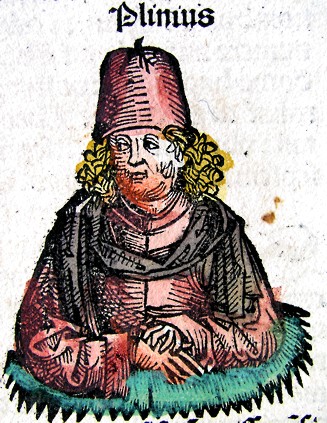
Liber chronicarum – 1493
di Hartmann Schedel (Norimberga 1440-1514)
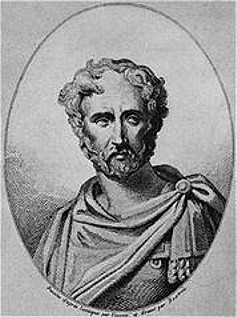
Pliny
the Elder: an imaginative 19th Century portrait.
No contemporary depiction of Pliny has survived.
Gaius or Caius Plinius Secundus (AD 23 – August 24, AD 79), better known as Pliny the Elder, was an ancient author, naturalist or natural philosopher and naval and military commander of some importance who wrote Naturalis Historia. He is known for his saying "True glory consists in doing what deserves to be written; in writing what deserves to be read".
He was the son of a Roman equestrian with the cognomen Celer by one Marcella, some say the daughter of the Senator Gaius or Caius Caecilius of Novum Comum (Como) others of one Titus, which suggests a possible connection with the Titii Pomponii, and being the connection with the Caecilii from Celer, cognomen used by that Gens.
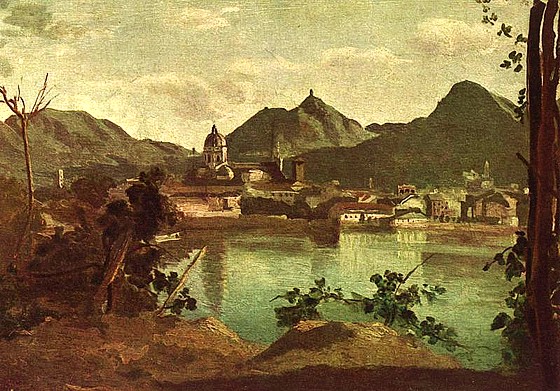
City and Lago of Como, painted by Jean-Baptiste Camille Corot, 1834.
He was born in Como, not (as is sometimes supposed) at Verona: it is only as a native of Gallia Transpadana that he calls Catullus of Verona his conterraneus, or fellow-countryman, not his municeps, or fellow-townsman. A statue of Pliny on the facade of the Duomo of Como celebrates him as a native son.
Student and lawyer
Before AD 35 Pliny's father took him to Rome, where he was educated and did his military service in Germania on his command under his father's friend, the poet and military commander Publius Pomponius Secundus, who inspired him with a lifelong love of learning. Two centuries after the death of the Gracchi, Pliny saw some of their autograph writings in his preceptor's library, and he afterwards wrote that preceptor's Life.
He mentions the grammarians and rhetoricians Remmius
Palaemon and Arellius Fuscus, and he may have been their student. In Rome he
studied botany in the topiarius (garden) of the aged Antonius Castor,
and saw the fine old lotus trees in the grounds that had once belonged to
Crassus. He also viewed the vast structure raised by Caligula, and probably
witnessed the triumph of Claudius over Britain in 44. Under the influence of
Seneca the Younger he became a keen student of philosophy and rhetoric, and
began practicing as an advocate.
Junior officer
He saw military service under Corbulo in Germania Inferior in 47, taking part in the Roman conquest of the Chauci and the construction of the canal between the rivers Maas and Rhine. As a young commander of cavalry (praefectus alae) he wrote in his winter-quarters a work on the use of missiles on horseback (De jaculatione equestri), with some account of the points of a good horse.
In Gaul and Hispania he learned the meanings of a number of Celtic words. He took note of sites associated with the Roman invasion of Germany, and, amid the scenes of the victories of Drusus, he had a dream in which the victor enjoined him to transmit his exploits to posterity. The dream prompted Pliny to begin forthwith a history of all the wars between the Romans and the Germans.
He probably accompanied his father's friend Pomponius on an expedition against the Chatti (50), and visited Germany for a third time (50s) as a comrade of the future emperor, Titus Flavius.
Literary interlude
Under Nero Pliny lived mainly in Rome. He mentions the map of Armenia and the neighbourhood of the Caspian Sea, which was sent to Rome by the staff of Corbulo in 58. He also saw the building of Nero's Domus Aurea or "Golden House" after the fire of 64.
Meanwhile he was completing the twenty books of his History of the German Wars, the only authority expressly quoted in the first six books of the Annals of Tacitus, and probably one of the principal authorities for the Germania. It was superseded by the writings of Tacitus, and, early in the 5th century, Symmachus had little hope of finding a copy.
He also devoted much of his time to writing on the comparatively safe subjects of grammar and rhetoric. A detailed work on rhetoric, entitled Studiosus, was followed by eight books, Dubii sermonis, in 67, which like the books on the German Wars, are now lost works.
Senior officer
Under his friend Vespasian he returned to the service of the state, serving as procurator in Gallia Narbonensis (70) and Hispania Tarraconensis (73), and also visiting the province of Gallia Belgica (74). During his stay in Hispania he became familiar with the agriculture and especially the gold mines of the country, besides paying a visit to Africa. His time in Hispania must have included visits to the gold mines in the north, because his descriptions of the various methods of mining bear the hallmark of the eye-witness, as discussed below. On his return to Italy he accepted office under Vespasian, whom he used to visit before daybreak for instructions before proceeding to his official duties, after the discharge of which he devoted all the rest of his time to study.
Famous author
He completed a History of His Times in thirty-one books, possibly extending from the reign of Nero to that of Vespasian, and deliberately reserved it for publication after his death. It is quoted by Tacitus, and is one of the authorities followed by Suetonius and Plutarch. However, it is now a lost work, like all of his other books apart from the Naturalis Historia.
He completed his great work the Naturalis Historia, an encyclopedia into which Pliny collected much of the knowledge of his time. The work had been planned under the rule of Nero. The materials collected for this purpose filled rather less than 160 volumes, which Larcius Licinus, the praetorian legate of Hispania Tarraconensis, vainly offered to purchase them for a sum equivalent to more than £3,200 (1911 estimated value) or £200,000 (2002 estimated value). Aside from minor finishing touches, the work in 37 books was completed in AD 77. Pliny dedicated the work to the emperor Titus Flavius Vespasianus in 77.
The Natural History
The only extant work of Pliny's is the Natural History; its survival is due to the very nature of the work, covering as it does almost the entire field of ancient knowledge, based on the best authorities. As a result it was used for reference over the following centuries by countless scholars, especially in medicine, plants and plant products (e.g., wine), agriculture, architecture, sculpture, geology and mineralogy.
At the conclusion of his literary labours, as the only Roman besides Lucretius who had ever taken for his theme the whole realm of nature, he prays for the blessing of the universal mother on his completed work. In literature he assigns the highest place next to Homer, Cicero and Virgil.
He takes a keen interest in nature, and in the natural sciences, studying them in a way that was then new in Rome, while the small esteem in which studies of this kind were held does not deter him from endeavouring to be of service to his fellow countrymen.
The scheme of his great work is vast and comprehensive, being nothing short of an encyclopedia of learning and of art so far as they are connected with nature or draw their materials from nature. He admits that:
My subject is a barren one - the world of nature, or in other words life; and that subject in its least elevated department, and employing either rustic terms or foreign, nay barbarian words that actually have to be introduced with an apology. Moreover, the path is not a beaten highway of authorship, nor one in which the mind is eager to range: there is not one of us who has made the same venture, nor yet one Greek who has tackled single-handed all departments of the subject.
And he admits the problems of writing such a work:
It is a difficult task to give novelty to what is old, authority to what is new, brilliance to the common-place, light to the obscure, attraction to the stale, credibility to the doubtful, but nature to all things and all her properties to nature.
For this work he studied the original authorities on each subject and was most assiduous in making excerpts from their pages. His indices auctorum are, in some cases, the authorities which he has actually consulted (though they are not exhaustive); in other cases, they represent the principal writers on the subject, whose names are borrowed second-hand for his immediate authorities. He frankly acknowledges his obligations to all his predecessors in a phrase that deserves to be proverbial, "plenum ingenni pudoris fateri per quos profeceris" or to own up to those who were the means of one's own achievements.
It was his scientific curiosity as to the phenomena of the eruption of Vesuvius that brought his life of continual study to a premature end; and any criticism of his faults of omission is disarmed by the candour of the confession in his preface: "nec dubitamus multa esse quae et nos praeterierint; homines enim sumus et occupati officiis" or Nor do we doubt that many things have escaped us also; for we are but human, and beset with duties.
Style
His style betrays the influence of Seneca. It aims less at clearness and vividness than at epigrammatic point. It abounds not only in antitheses, but also in questions and exclamations, tropes and metaphors, and other mannerisms of the Silver Age. The rhythmical and artistic form of the sentence is sacrificed to a passion for emphasis that delights in deferring the point to the close of the period. The structure of the sentence is also apt to be loose and straggling. There is an excessive use of the ablative absolute, and ablative phrases are often appended in a kind of vague "apposition" to express the author's own opinion of an immediately previous statement, e.g., "dixit (Apelles) ... uno se praestare, quod manum de tabula sciret tollere, memorabili praecepto nocere saepe nimiam diligentiam".
Highlights
A special interest attaches to his account of the manufacture of the papyrus, and of the different kinds of purple dye, while his description of the notes of the nightingale is an elaborate example of his occasional felicity of phrase. He also gave eye-witness accounts of gold mining in Hispania, accounts which have been confirmed by the visible remains especially at Las Medulas.
Some of Pliny's wisest and most famous adages include:
Among these things, one thing seems certain - that nothing certain exists and that there is nothing more pitiful or more presumptuous than man.
Because of a curious disease of the human mind, it pleases us to enshrine in history records of bloodshed and slaughter, so that those ignorant of the facts of the world may become acquainted with the crimes of mankind.
Vesuvius
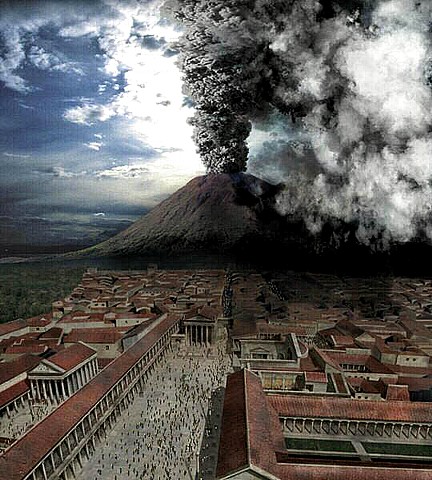
Computer-generated
imagery of the eruption of Vesuvius
in BBC/Discovery Channel's co-production Pompeii.
He received from Vespasian the appointment of prefect of the Roman Navy. On August 24, 79 AD, he was stationed at Misenum, at the time of the great eruption of Mount Vesuvius, which overwhelmed Pompeii and Herculaneum. A desire to observe the phenomenon directly, and also to rescue some of his friends from their perilous position on the shore of the Bay of Naples, led to the launching of his galleys and crossing the bay to Stabiae (near the modern town of Castellammare di Stabia). His nephew, whom he had adopted, Pliny the Younger, provided an account of his death, and suggested that he collapsed and died through inhaling poisonous gases emitted from the volcano. His body was found interred under the ashes of the Vesuvium with no apparent injuries on 26 August, after the plume had dispersed, tending to confirm asphyxiation or poisoning.
The story of his last hours is told in an interesting letter addressed twenty-seven years afterwards to Tacitus by the Elder Pliny's nephew and heir, Pliny the Younger, who also sent to another correspondent an account of his uncle's writings and his manner of life:
Pliny is still remembered in volcanology where the term Plinian (or Plinean) refers to a very violent eruption of a volcano marked by columns of smoke and ash extending high into the stratosphere. The term ultra-Plinian is reserved for the most violent type of Plinian eruption such as the 1883 destruction of Krakatoa.
Research after 1500
A carnelian inscribed with the letters C. PLIN. has been reproduced by Cades (v.211) from the original in the Vannutelli collection. It represents an ancient Roman with an almost completely bald forehead and a double chin; and is almost certainly a portrait, not of Pliny the Elder, but of Pompey the Great. Seated statues of both the Plinies, clad in the garb of scholars of the year 1500, may be seen in the niches on either side of the main entrance to the cathedral church of Como. The elder Pliny's anecdotes of Greek artists supplied Vasari with the subjects of the frescoes which still adorn the interior of his former home at Arezzo.
Modern research
Pliny's description of gold mining methods (book xxxiii, chapter 21) has been confirmed by field work and archaeology, especially the use of water power in sluicing alluvial gold ores, both in Britain at Dolaucothi in South Wales, at Las Medulas and many other mines in northern Spain. His description of construction of the aqueducts needed to prospect for gold-bearing ore by removing overburden and work the alluvial deposits bears the hall marks of the eye-witness, and he served as Procurator in northern Hispania when the region in 73 AD was experiencing a gold rush. The memory must thus have been fresh in his mind when he wrote Book xxxiii. As the mines grew, more water was supplied simply by building new aqueducts along the line of the original, and the remains of such multiple systems are still visible at Dolaucothi and Las Medulas.
Such methods of hydraulic mining were used widely during the gold rushes of California and Australia in the Victorian period. By contrast with aqueducts providing potable water for towns and cities, those used in mining had a higher gradient so as to provide a faster stream top speed operations, and consequently a shorter life. It seems clear that the methods of hydraulic mining such as hushing were a Roman innovation, nothing comparable being known in previous times. No doubt their skills at aqueduct building promoted their less well-known use in large-scale mining, as attested by Pliny.
The research at Dolaucothi has shown how aqueducts could be used not just for prospection, but also for removing waste rock. A large tank would be built at the end of the aqueduct, and once a vein found, it was attacked using fire-setting (building a fire against the rock, then dousing with water) and the precious ore-bearing minerals extracted by hand. The waste or barren rock surrounding the vein was then washed away, again by using the wave of water from a full tank to scour the waste away. Pliny actually recommends a particular size of tank (200 by 200 feet, and 10 feet deep), but those found on the ground at Dolaucothi vary greatly in size, and are smaller than he says. The same water supply was then used as a gentle stream to wash the crushed ore, the gold particles being collected in riffle boxes. At least two of the tanks used at the gold mine still hold water, a tribute to their builders nearly 2000 years ago.
Dictionnaire
historique
de la médecine ancienne et moderne
par Nicolas François Joseph Eloy
Mons – 1778